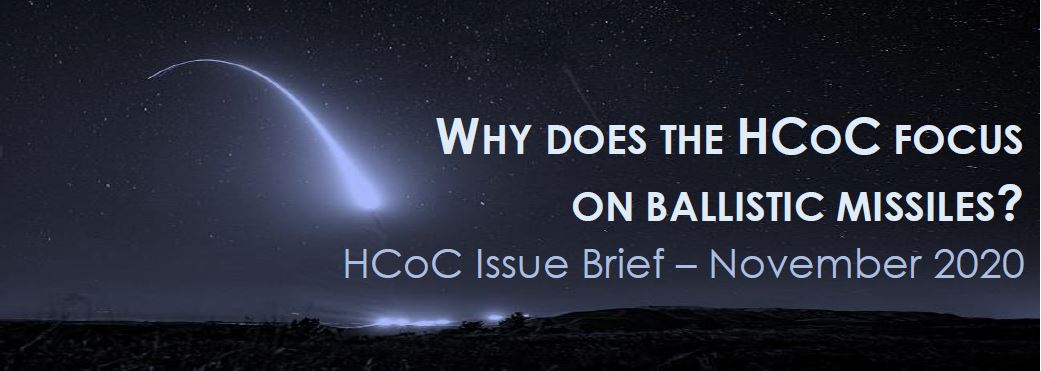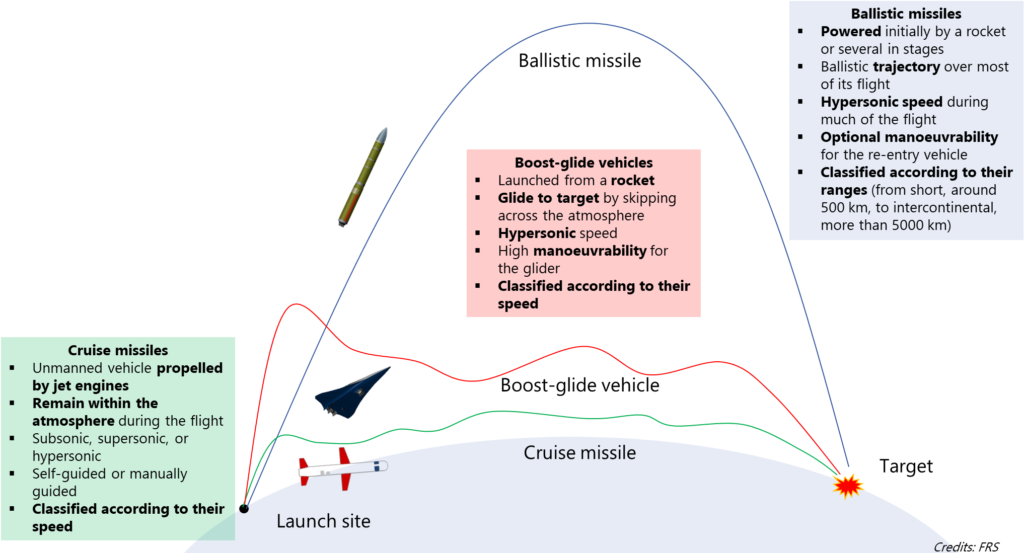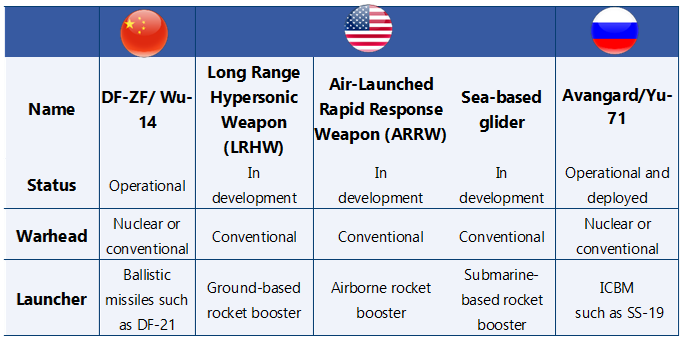
The Hague Code of Conduct against ballistic missile proliferation (HCoC) was adopted to contribute to the efforts to counter weapons of mass destruction (WMDs) proliferation, an objective that is emphasized in the preamble of the Code. This instrument focuses not on the weapons themselves (whether nuclear, chemical, biological or bacteriological) but rather on their means of delivery. As ballistic missiles remain the delivery vehicle of choice for WMD programmes, the HCoC is logically centred on this delivery system.
However, in the past two decades, cruise missiles have also emerged as a potential threat due to some of their features, which make them potentially adaptable to carrying WMDs, but also because a growing number of states have acquired them. Moreover, the emergence of new technologies such as hypersonic manoeuvring weapons also brings into question the scope of the HCoC.
A focus on ballistic missiles as the main WMD delivery vehicles
Ballistic missiles have traditionally been associated with WMD programmes. Indeed, all countries that have acquired nuclear, chemical, or biological weapons since the end of the Cold War have also procured or produced ballistic systems, and some coupled their ballistic missiles with WMDs. Ballistic missiles are generally considered the preferred delivery vehicle for WMDs because they can usually reach their target without being intercepted, even when rudimentary systems are used by countries without a highly developed technological and industrial base.
Designed as a tool to counter the proliferation of missiles able to carry WMDs, the HCoC was therefore immediately associated with ballistic missiles, which at the time of its negotiation had been widely imported or developed independently for non-conventional purposes by countries such as North Korea, Iran, Iraq, Syria and Libya.
In brief
The Hague Code of Conduct focuses on ballistic missiles as they remain the preferred delivery vehicle for WMDs. The HCoC therefore regulates one of the most dangerous types of weapons in existence.
Since its inception, the HCoC has been criticised for not including other systems, in particular cruise missiles. While cruise missiles can be used for non-conventional purposes, they are also used regularly in military operations. As a result, states are less willing to commit to transparency measures on such weapons.
As new types of WMD delivery vehicles emerge, including hypersonic manoeuvring missiles, the question of their inclusion in the HCoC will be a key factor in maintaining its relevance.
Author : Emmanuelle Maitre and Lauriane Héau, FRS
The difficulty of integrating cruise missiles in the HCoC?

In 2002, when the HCoC was created, cruise missiles were already used by some states to carry nuclear weapons, in particular the air-launched missiles AGM-86, developed by the United States, and the French ASMP (both deployed in 1986). However, at the time, these systems were mostly held by states considered to be nuclear powers under the Non-proliferation Treaty (NPT), and not widely present in states suspected of proliferation activities.
While risks associated with cruise missiles were therefore underestimated at the time, some diplomats and experts, during the negotiation of the HCoC, nonetheless spoke in favour of creating confidence-building measures (CBMs) on cruise missiles. However, they faced several obstacles. The first difficulty was the absence of an agreed definition of cruise missiles. Implementing confidence-building measures on cruise missiles faced another major hurdle in that a majority of cruise missile possessors would refuse to pre-notify the testing or use of missile systems unrelated to WMDs. Cruise missiles, then and now, are weapons used on the battlefield and are not limited to nuclear deterrence strategies. For example, the US Tomahawk cruise missile was used 288 times in the 1991 Gulf War, 802 times during the invasion of Iraq in 2003 and, more recently, 57 times in the bombings of Damascus and Homs on 13 April 2018.i States are therefore unlikely to display the level of transparency required by the HCoC on weapons that they use regularly in military operations. Already, actors that use conventional ballistic missiles in the theatre, such as Iran, show a great reluctance to join the HCoC and to provide transparency on their ballistic systems. Finally, cruise missiles are more often exported in the framework of the Missile Technology Control Regime (MTCR), and their possessors, especially Western states, often do not perceive their dissemination as entailing proliferation risks given that most systems which are being exported have only short or medium ranges and are not designed to deliver WMDs.
A limited scope for the HCoC
In order to facilitate the conclusion of negotiations, maintain consensus, avoid lengthy deliberations about delicate technical definitions and encourage subsequent implementation, a restricted scope – encompassing ballistic missiles and space launchers – was therefore favoured when the HCoC was signed. It has since been supported by most subscribing states, although some still question the HCoC’s current scope (see text beside).
During the first years of the HCoC, subscribing states focused on two main priorities. The first was to ensure correct implementation, especially by convincing the United States and Russia to fulfil their obligations as the two states initially refused to submit pre-notifications of launches and preferred instead using their bilateral framework. Efforts have been made to improve compliance with regard to annual declaration and pre-notification commitments through a set of concrete initiatives. For instance, a pre-filled ‘nil’ form was introduced for states that do not have ballistic or space capabilities, and improvements were made on the internet platform on which states upload their declarations. As a result, reporting rates have increased significantly. The second priority was to promote the universalisation of the HCoC through awareness-raising efforts in different regions of the world, resulting in an increase from 93 subscribing states when the HCoC was adopted to 143 in 2020.

The question of hypersonic manoeuvring systems

Hypersonic systems are often perceived as disruptive technologies and propositions have emerged to include them in arms control and non-proliferation agreements. These vehicles are currently being developed by China, the United States, and Russia (Figure 2) and a handful of other states are also interested in acquiring this technology, including India and France. Hypersonic weapons, which can carry conventional as well as nuclear warheads, can be broken down into two major families:
Scramjet-powered cruise missiles are powered by high-speed (1.5 km/s), high-altitude (20 to 30 km) air-breathing engines, or ‘scramjets’ during their flight – similarly to existing cruise missiles.
Hypersonic glide vehicles differ in their trajectories: initially launched by a space launcher or a ballistic missile, they then complete most of their flight along a non-ballistic trajectory in the atmosphere, by bouncing back on its layers.
The HCoC does not cover scramjet-powered cruise missiles. However, when they rely on a ballistic missile for the boost phase (from launch to the end of the propulsion by the engine), hypersonic glide vehicles – which is where most progress has been made – are subject to pre-launch notifications by HCoC subscribing states. This is in particular the case of the Russian Avangard, the first hypersonic system operationally deployed in December 2019.v
About the Hague Code of Conduct
Adopted in 2002, the Hague Code of Conduct against Ballistic Missile Proliferation (HCoC) is a politically binding instrument aiming to limit the proliferation of weapons of mass destruction (WMD) delivery vehicles. Composed of a set of transparency and confidence-building measures, the HCoC is the only existing multilateral instrument that focuses on WMD delivery vehicles. The HCoC has reached 143 subscribing states (September 2021) vs 93 at its inception.
When subscribing to the HCoC, states commit to abide by a set of UN treaties and international conventions on space security; to produce an annual declaration regarding ballistic missile capacities and national policy on non-proliferation and disarmament treaties and instruments; and to deliver pre-launch notifications prior to any missile or space launch. Documents are uploaded onto a dedicated online platform managed by Austria, which acts as the HCoC Immediate Central Contact (Executive Secretariat). Subscription to the HCoC is free of charge.
While subscribing states are asked to exercise ‘maximum restraint’ in the development of ballistic capacities, they are proscribed neither from possessing ballistic missiles nor from pursuing space launch activities. In return, subscribing to the HCoC enables states to gain access to information shared by other subscribing states, and to display their political commitment to non-proliferation and disarmament.
i Stéphane Delory, Emmanuelle Maitre and Jean Masson, ‘Opening HCoC to cruise missiles: A proposal to overcome political hurdles,’ HCoC Research Paper No. 5, Foundation for Strategic Research (FRS), February 2019.
ii Statement by Ambassador Friedrich Däuble, Permanent Representative of Germany to the United Nations in Vienna and other International Organisations, HCoC Annual Conference of States Signatories, 28th to 29th May 2018, https://wien-io.diplo.de/iow-de/aktuelles/-/2089842.
iii United Nations, Hague Code of Conduct against Ballistic Missile Proliferation welcomed in text approved by Disarmament Committee, First Committee, GA/DIS/3286, 26 October 2004, https://www.un.org/press/en/2004/gadis3286.doc.htm.
iv See also Dennis Gormley, Missile Contagion: Cruise Missile Proliferation and the Threat to International Security, Praeger Security International, 2008; Mark Smith, ‘The HCoC: current challenges and future possibilities,’ HCoC Research Paper No. 1, FRS, 2014; and Stéphane Delory, Emmanuelle Maitre and Jean Masson, op. cit.
v ‘Russia deploys Avangard hypersonic missile system,’ BBC News, 27 December 2019.



